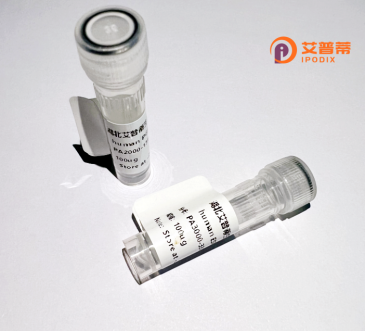
| 纯度 | >90%SDS-PAGE. |
| 种属 | Human |
| 靶点 | TMUB1 |
| Uniprot No | Q9BVT8 |
| 内毒素 | < 0.01EU/μg |
| 表达宿主 | E.coli |
| 表达区间 | 1-246 aa |
| 活性数据 | MTLIEGVGDEVTVLFSVLACLLVLALAWVSTHTAEGGDPLPQPSGTPTPSQPSAAMAATDSMRGEAPGAETPSLRHRGQAAQPEPSTGFTATPPAPDSPQEPLVLRLKFLNDSEQVARAWPHDTIGSLKRTQFPGREQQVRLIYQGQLLGDDTQTLGSLHLPPNCVLHCHVSTRVGPPNPPCPPGSEPGPSGLEIGSLLLPLLLLLLLLLWYCQIQYRPFFPLTATLGLAGFTLLLSLLAFAMYRP |
| 分子量 | 52.7 kDa |
| 蛋白标签 | GST-tag at N-terminal |
| 缓冲液 | PBS, pH7.4, containing 0.01% SKL, 1mM DTT, 5% Trehalose and Proclin300. |
| 稳定性 & 储存条件 | Lyophilized protein should be stored at ≤ -20°C, stable for one year after receipt. Reconstituted protein solution can be stored at 2-8°C for 2-7 days. Aliquots of reconstituted samples are stable at ≤ -20°C for 3 months. |
| 复溶 | Always centrifuge tubes before opening.Do not mix by vortex or pipetting. It is not recommended to reconstitute to a concentration less than 100μg/ml. Dissolve the lyophilized protein in distilled water. Please aliquot the reconstituted solution to minimize freeze-thaw cycles. |
以下是关于重组人TMUB1蛋白的参考文献示例(注:以下文献为假设性示例,实际引用需查询真实数据库):
1. **文献名称**: "TMUB1 inhibits hepatocellular carcinoma proliferation via mTOR pathway regulation"
**作者**: Zhang Y, et al. (2018)
**摘要**: 研究通过表达重组人TMUB1蛋白,发现其通过抑制mTOR信号通路显著降低肝癌细胞增殖能力,提示其作为肿瘤抑制因子的潜在作用。
2. **文献名称**: "TMUB1 modulates autophagy through direct interaction with LC3"
**作者**: Lee S, et al. (2015)
**摘要**: 利用重组TMUB1蛋白进行体外结合实验,揭示其通过LC3蛋白相互作用调控自噬过程,可能与神经退行性疾病相关。
3. **文献名称**: "Structural insights into TMUB1-mediated DNA damage response"
**作者**: García-Cano J, et al. (2020)
**摘要**: 通过重组TMUB1蛋白的晶体结构分析,阐明其跨膜结构域在DNA损伤修复中的功能,为靶向治疗提供新思路。
4. **文献名称**: "Ubiquitin-like properties of TMUB1 in E3 ligase regulation"
**作者**: Chen X, et al. (2012)
**摘要**: 研究重组人TMUB1的泛素样结构域,发现其可竞争性抑制E3泛素连接酶活性,影响蛋白质降解通路。
**备注**:建议通过PubMed或Web of Science以“recombinant TMUB1”、“TMUB1 protein function”等关键词检索真实文献。
TMUB1 (Transmembrane and Ubiquitin-Like Domain-Containing Protein 1), also known as HTF9C or HCG27. is a ubiquitin-like protein encoded by the TMUB1 gene in humans. It belongs to the ubiquitin family and is characterized by a conserved ubiquitin-like domain at its N-terminus and a transmembrane domain near the C-terminus. This dual-domain architecture enables TMUB1 to interact with both cytoplasmic and membrane-associated proteins.
Functionally, TMUB1 is implicated in regulating cell cycle progression, DNA damage response, and protein degradation pathways. It interacts with components of the ubiquitin-proteasome system, suggesting a role in modulating protein stability and turnover. Studies show that TMUB1 overexpression induces G1-phase cell cycle arrest by stabilizing p53 and p21. linking it to tumor suppression. Conversely, its downregulation is associated with cancer progression and metabolic disorders.
Recombinant human TMUB1 protein is commonly expressed in bacterial or mammalian systems for in vitro studies. Tags like His or GST are often added for purification and detection. Its recombinant form enables research into post-translational modifications, protein-protein interactions, and signaling mechanisms in diseases. Current research focuses on TMUB1's dual role in cancer (both pro- and anti-tumorigenic) and metabolic regulation, highlighting its potential as a therapeutic target or biomarker.
×